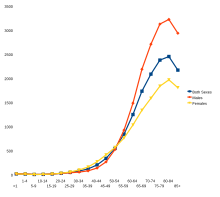Evolutionary medicine or Darwinian medicine is the application of modern evolutionary theory to understanding health and disease. Modern medical research and practice have focused on the molecular and physiological mechanisms underlying health and disease, while evolutionary medicine focuses on the question of why evolution has shaped these mechanisms in ways that may leave us susceptible to disease. The evolutionary approach has driven important advances in the understanding of cancer, autoimmune disease, and anatomy. Medical schools have been slower to integrate evolutionary approaches because of limitations on what can be added to existing medical curricula.
Core principles
Utilizing the Delphi method, 56 experts from a variety of disciplines, including anthropology, medicine, and biology agreed upon 14 core principles intrinsic to the education and practice of evolutionary medicine. These 14 principles can be further grouped into five general categories: question framing, evolution I and II (with II involving a higher level of complexity), evolutionary trade-offs, reasons for vulnerability, and culture. Additional information regarding these principles may be found in the table below.
Human adaptations
Adaptation works within constraints, makes compromises and trade-offs, and occurs in the context of different forms of competition.
Constraints
Adaptations can only occur if they are evolvable. Some adaptations which would prevent ill health are therefore not possible.
- DNA cannot be totally prevented from undergoing somatic replication corruption; this has meant that cancer, which is caused by somatic mutations, has not (so far) been completely eliminated by natural selection.
- Humans cannot biosynthesize vitamin C, and so risk scurvy, vitamin C deficiency disease, if dietary intake of the vitamin is insufficient.
- Retinal neurons and their axon output have evolved to be inside the layer of retinal pigment cells. This creates a constraint on the evolution of the visual system such that the optic nerve is forced to exit the retina through a point called the optic disc. This, in turn, creates a blind spot. More importantly, it makes vision vulnerable to increased pressure within the eye (glaucoma) since this cups and damages the optic nerve at this point, resulting in impaired vision.
Other constraints occur as the byproduct of adaptive innovations.
Trade-offs and conflicts
One constraint upon selection is that different adaptations can conflict, which requires a compromise between them to ensure an optimal cost-benefit tradeoff.
- Running efficiency in women, and birth canal size
- Encephalization, and gut size
- Skin pigmentation protection from UV, and the skin synthesis of vitamin D
- Speech and its use of a descended larynx, and increased risk of choking
Competition effects
Different forms of competition exist and these can shape the processes of genetic change.
- mate choice and disease susceptibility
- genomic conflict between mother and fetus that results in pre-eclampsia
"Diseases of civilization"
Humans evolved to live as simple hunter-gatherers in small tribal bands. Contemporary humans now have a very different environment and way of life. This change makes present humans vulnerable to a number of health problems, termed "diseases of civilization" and "diseases of affluence". Stone-age humans evolved to live off the land, taking advantage of the resources that were readily available to them. Evolution is slow, and the rapid change from stone-age environments and practices to the world of today is problematic because we are still adapted to stone-age circumstances that no longer apply. This misfit has serious implications for our health. "Modern environments may cause many diseases such as deficiency syndromes like scurvy and rickets".)
Diet
In contrast to the diet of early hunter-gatherers, the modern Western diet often contains high quantities of fat, salt, and simple carbohydrates, such as refined sugars and flours. These relatively sudden dietary changes create health problems.
- Trans fat health risks
- Dental caries
- High GI foods
- Modern diet based on "common wisdom" regarding diets in the paleolithic era
Life expectancy
Examples of aging-associated diseases are atherosclerosis and cardiovascular disease, cancer, arthritis, cataracts, osteoporosis, type 2 diabetes, hypertension and Alzheimer's disease. The incidence of all of these diseases increases rapidly with aging (increases exponentially with age, in the case of cancer).
Of the roughly 150,000 people who die each day across the globe, about two thirds—100,000 per day—die of age-related causes. In industrialized nations, the proportion is much higher, reaching 90%.
Exercise
Many contemporary humans engage in little physical exercise compared to the physically active lifestyles of ancestral hunter-gatherers. Prolonged periods of inactivity may have only occurred in early humans following illness or injury, so a modern sedentary lifestyle may continuously cue the body to trigger life preserving metabolic and stress-related responses such as inflammation, and some theorize that this causes chronic diseases.
Cleanliness
Contemporary humans in developed countries are mostly free of parasites, particularly intestinal ones. This is largely due to frequent washing of clothing and the body, and improved sanitation. Although such hygiene can be very important when it comes to maintaining good health, it can be problematic for the proper development of the immune system. The hygiene hypothesis is that humans evolved to be dependent on certain microorganisms that help establish the immune system, and modern hygiene practices can prevent necessary exposure to these microorganisms. "Microorganisms and macroorganisms such as helminths from mud, animals, and feces play a critical role in driving immunoregulation" (Rook, 2012). Essential microorganisms play a crucial role in building and training immune functions that fight off and repel some diseases, and protect against excessive inflammation, which has been implicated in several diseases. For instance, recent studies have found evidence supporting inflammation as a contributing factor in Alzheimer's Disease.


